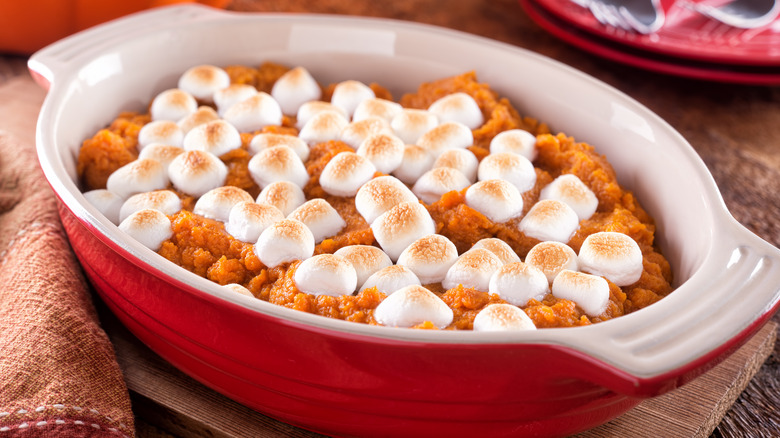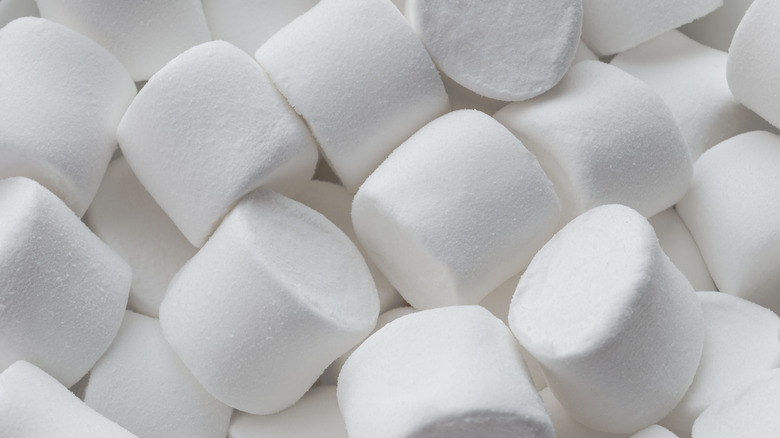How Did Marshmallows End Up On Sweet Potatoes?
With 5 grams of sugar, or a little more than a teaspoon, in every medium-sized sweet potato, they certainly earn the name. But that hasn't stopped Americans from finding ways to make the orange tuber an even more sweet part of their diet. It's a longstanding tradition, with "American Cookery," a 1796 cookbook, including a recipe for a really sweet "potato pudding." The recipe called for a pound of mashed sweet potatoes and a half-pound of sugar, along with butter, milk, nutmeg, and eggs. A century later, per Mental Floss, the fascination with making sweet potatoes even sweeter was continuing, as the first edition of the Boston Cooking School Cookbook from 1896 included "a recipe for glazed or candied sweet potatoes."
So maybe it shouldn't come as much of a surprise that, in the search for ways to make sweet potato dishes even sweeter, Americans would — just a generation or so later after the publication of the Boston Cooking School Cookbook — turn to what was then a newfangled confection to get the job done. That new confection was the marshmallow, a mass-produced descendant of the sweet dietary and medicinal preparation from the root of the marshmallow plant, a flowering plant initially found in marshy areas of western Europe and northern Africa and used for millennia that today also grows in North America. And that is how Thanksgiving tables across the country — or many of them, anyway — would come to include sweet potato casserole topped with browned marshmallows.
Blame the French and big corporations
If you're looking for someone to blame for toasted marshmallows atop sweet potato casserole, start with 19th-century French confectioners and end with early-20th-century corporate America. According to Vice, French confectioners realized the sweetness of the traditional medicinal concoction from the marshmallow plant could be reproduced by cooking up sugar, water, and gelatin. Later, an American company, Angelus Marshmallows, introduced commercially produced marshmallows, and in 1917, a decade after they began mass-producing marshmallows, brothers Frederick and Louis Rueckheim wanted to expand the market. They enlisted Janet McKenzie Hill of Boston Cooking School Magazine to develop recipes to make marshmallows an everyday ingredient. Among her creations, Mental Floss states, were "mashed sweet potatoes baked with a marshmallow topping."
In the years after Hill's recipe, a North-South regional bias appeared. According to Saveur, the South was represented by Harriet Ross Colquitt in her 1933 "The Savannah Cook Book." In a recipe for candied sweet potatoes, Colquitt referenced recipes with marshmallows, but called her unembellished dish "far, far nicer." Conversely, just four years earlier in the North, Chicago native Caroline B. King had described a recipe for twice-baked sweet potatoes by noting "a topping of halved or quartered marshmallows ... improves even this luscious dish."
Today, any regional bias seems to have vanished, and yet, no one can agree on a single recipe. On Reddit, an incredulous Irish commenter asked if sweet potato casserole really came topped with marshmallows. Needless to say, a heated debate ensued, with different people commenting on their preferred preparation.

